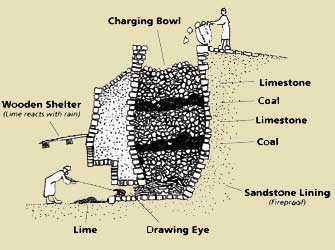Beauvais Family of Perche.
Percheron Migration.
Gabriel Beauvais (the son of François Beauvais and Marie Tichot) and Marie Cronière were married in Marcilly, France on 11 May 1620. Records for three children were found in Saint-Martin church in Igé, Perche. A son François was born about 1621; it appears he never married but his death record was found for 22 February 1646. Another son, our ancestor Jacques was born 22 November 1623. Daughter Marie was baptized 6 April 1626.
So many from this province left for Québec, including Jacques Surprenant, another of our ancestors, that the exodus became known as the Percheron Immigration. Jacques Beauvais dit Saint-Gemme, 29, was first mentioned in the New World in a contract he made with Charles Sevestre on 16 Sep 1652. He began his trade as a chaufournier or lime burner.
Chaufournier.
Lime was used in tanning animal hides, making soap, and to enrich the soil for farming. And it is a necessary component of the mortar used to secure stones when constructing buildings. The chaufournier collected oyster shells or chips of marble or limestone from the stone mason's yard for the raw material to make lime putty. A kiln was constructed of brick or clay with air vents to regulate the interior heat and had thick walls built for resilience.

Loosely packed wood was set to burn down to coal in the bottom of the kiln. The shell or stone was layered atop, followed by more wood for the steady heat needed to burn the lime to remove carbon dioxide. Building the layers of wood and lime in the kiln could take a day, followed by several days of firing. Including cooling, the process took a week to complete. For this reason a large construction project required several kilns started on staggered days to insure a steady supply of mortar for the stone mason.
The calcined shell must immediately be placed in a pot of warm water to slake. The resulting chemical reaction was among the first discovered by ancient man as the fresh burned lime reacts with water and hisses and boils as it forms a putty. Care had to be taken as the material was highly caustic at this stage. It was used right away, but could be stored by a covering of water to prevent the putty from reabsorbing CO2 and reverting to limestone.
- Jetté, René, Dictionnaire généalogique des familles du Quebec des origines à 1730 (Montréal: Les Presses de l'Université de Montréal, 1983)
- image from:https://www.bgs.ac.uk/mendips/aggregates/history/limeburning.html
- parkscanadahistory: Canadian Historic Sites: Occasional Papers in Archaeology and History No. 12 Lime Preparation at 18th-Century Louisbourg, by Charles S. Lindsay
- www.fichierorigine.com BEAUVAIS / ST-GEMME, Jacques 240269
